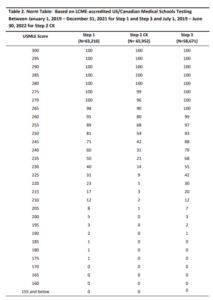Step 3 Percentiles and Placing in the Top

33700 Views
Grant yourself a moment to take a nice big congratulatory breath! You’ve thrived (some would say survived) through undergrad, the MCAT, medical school, Step 1 and 2, and the match. That’s pretty stellar! What better way to celebrate than another 2-day, ~16-hour exam? In this blog post, we will discuss the last step in becoming an MD, the USMLE Step 3, its percentiles, and how to place on top!
USMLE Step 3: How Important is Achieving a Score in the Top Percentiles?
Let’s be frank: in the vast majority of cases, knocking Step 3 out of the park and achieving a score in the top percentiles should not be your priority. Your score on this test carries far less weight in determining your future in your dream field. But that is outside of the scope of this conversation. Whether you’re aiming for a solid, middle-of-the-bell-curve pass or you’re hoping to score higher on that curve, you should always keep the following in mind:
- You are not ready to sit for this exam until you are confident that you are going to pass. Although scoring high may not have an impact on your future, failing this exam might. The test is also way too expensive to pay for twice on our residency salary!
- You have a lot on your plate and you need to preserve your mental wellness.
- You should do as well as you can while also remembering #2.
What is Needed to Pass the USMLE Step 3?
Alright, let’s get down to business. A few numbers you should know are 198, 228, and 15, which are the passing score, the mean score, and the standard deviation respectively. A failing score on Step 3 falls somewhere between the 2nd and 3rd percentiles. Although the USMLE is not entirely transparent with its scoring algorithm, a passing score correlates with about 60% correct. The mean score, 228, is much lower than the mean scores for step 1 (232) and step 2 (246), which speaks to the fact that these tests are viewed very differently. In general, you should aim to score somewhere within 1 SD of the mean (213-243).
Staying on Track to Pass
Now that we’ve established a goal, what are some things you can do to accomplish that goal? Here are 5 tips to get you started on the right track to passing your USMLE Step 3.
1. Don’t Test Until You Aare Ready
I know I sound like a broken record, but this is important and bears repeating. As much as you may feel like your practice test scores are not an accurate representation of your true test day performance (tired from taking a test post-call, distracted by your attention-demanding pet, answering your phone in the middle of a block… etc) you should not expect your score to significantly jump on test day. As much as there are distractions and complicating factors at home, there are also unique factors that will come up on test day, such as anxiety, especially if day 1 didn’t go as planned. Make this a one-and-done ordeal!
2. Apply Knowledge From Patient Care
This test is designed to make sure you are safe to provide patient care so it really should be a test of what you do every day at work. Of course, this may vary based on your specialty, but much of this exam does rely on knowledge that a resident would regularly use (including the interpretation of medical literature). Make sure you focus on understanding why you do things in the hospital, the timing and urgency of labs/procedures, and paying attention to management from consulting teams.
3. Focus on Your Weaknesses
We’ve all got ’em! Depending on your residency specialty, some test takers may have larger gaps than others. In general, residents in internal medicine, family medicine, EM, and general surgery encounter a broader scope of the material that will be tested on this exam. These test takers should focus on the areas that are encountered least in their work. Test takers in the more niche specialties may need to dedicate more time to covering the broad sweeping, general concepts. As good as it may feel to do questions in your comfort zone, this isn’t going to give you as much of a benefit in preparing for test day.
4. Don’t Forget About Biostatistics for USMLE Step 3
Eye roll. I know. But this test is relatively heavy on biostatistics because the test writers want to know that you are able to critically engage with medical literature. After all, they have a good point! The good news is that it is relatively easy to do a quick, deep dive into the world of USMLE biostatistics. You should watch a few videos, memorize and understand your equations, and zip through the practice questions in UWorld.
5. Work Around Your Residency Schedule
If you are shooting for the mean and you are in a broad residency field, you really should be able to fit in enough studying without using up a vacation or elective block. However, if you are struggling to pass or if you are looking to score in the highest percentile, you may want to consider lining up your test with the lightest workload in your schedule. For example, an outpatient/elective block going into vacation block would be a great set-up for someone who is really looking to put in more time.
#1-3 are non-negotiable. These are an absolute must if you are going to be successful on the test. #4-5 become more important based on how high you aim to score on this exam. Now go out there and show them what you’re made of! If you are looking for some extra assistance, consider enlisting the help of a USMLE Step 3 tutor. Schedule a consultation to hear more about how Elite Medical Prep can help you succeed today!
Featured Articles

